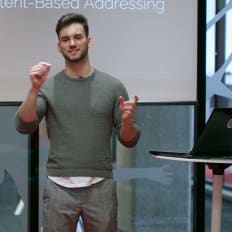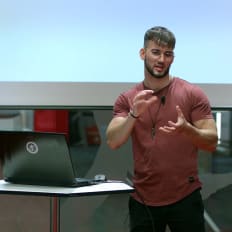
DEVJobs.at
Die TechTalk Days
Description
Klemens Schreiber erzählt in seinem devjobs.at TechTalk den Werdegang des Karriereportals und den Hintergrund der TechTalk Days.
By playing the video, you agree to data transfer to YouTube and acknowledge the privacy policy.
Video Summary
In Die TechTalk Days, Klemens Schreiber introduces the DevJobs.at TechTalk Days, shares how DevJobs.at started (from an early prototype using an Express app and SaaS components), and explains the mission to increase transparency in Austria’s developer job market in response to vague job postings. He announces 30+ speakers from Austrian dev teams with all talks freely available on devjobs.at and techtalks.at, enabling viewers to access and learn from a broad range of topics on demand.
Die TechTalk Days: Klemens Schreiber (DEVJobs.at) on transparency in developer hiring and the pragmatic path from an Express prototype to an open knowledge stage
Framing the session “Die TechTalk Days” with Klemens Schreiber (DEVJobs.at)
“Die TechTalk Days” inaugurates a format built around a simple promise: give developers from real teams a stage to share knowledge—freely and online. In his brief but pointed opening remarks, Klemens Schreiber, CTO and Co‑Founder of DEVJobs.at, outlines the motivation behind the job portal, the first technical prototype, and the mission of the event.
Core idea: DEVJobs.at emerged from a very real developer pain—lack of transparency in standard job ads. With the TechTalk Days, that principle of openness extends to knowledge itself: more than 30 speakers from diverse dev teams share content that will remain freely available on DEVJobs.at and techtalks.at.
“Ground‑breaking projects in established companies” and “cutting‑edge technologies in agile teams”—phrases like these were the start of the problem: big words with very little actionable signal for engineers.
Below, we recap the technical and organizational lines of this opening session, connect them to engineering practice, and distill takeaways for teams building developer products or turning their engineering work into durable, accessible knowledge.
From a kid’s room to the first prototype: start small, ship early
Klemens Schreiber traces the origins of DEVJobs.at: he and his co‑founder started in their “first office,” his child’s room. It’s a scene familiar to many engineering efforts: constrained resources, sharp problem focus, fast execution.
That first version consisted of:
- “a few SWL components,”
- “an Express app,”
- “various SaaS solutions.”
The outcome: a working prototype, and “a large part of this software is still online today.” That statement underscores a key engineering lesson: early, pragmatic, problem‑centric systems can be robust enough to remain in production when chosen with care.
Early‑phase principles we can extract
- Build right against the problem: the lack of transparency in job descriptions was the starting point. A crisp product aim sharpens your minimal feature set.
- Favor small, proven building blocks: an Express app, a handful of components, and SaaS are plenty to reach real users.
- Keep what works: if early architecture choices serve the core purpose well, there’s no inherent need to discard them as the product grows.
The problem space: buzzwords don’t substitute substance
The diagnosis is direct: standard job listings leaned on “ground‑breaking” and “cutting‑edge,” but left essential engineering facts open. In practice, that means insufficient signal about actual responsibilities, concrete tech stacks, how teams collaborate, or how quality is ensured.
“With that kind of information, there isn’t much you can really do.”
DEVJobs.at’s mission follows naturally: bring more transparency to the developer landscape in Austria so every developer can find a fitting job. That mission becomes a product compass: fewer buzzword decorations, more substance—both on the supply and demand side.
What transparency means for developers
Without inventing details beyond the talk, the intent is clear. Transparent tech job communication aims for:
- concrete, verifiable technology disclosures (versions, frameworks, systems),
- clarity around responsibilities and scope (day‑to‑day, ownership, interfaces),
- development practices (code reviews, testing, deployment cadence),
- team setup and collaboration (pairing, chapters/tribes, remote levels),
- real problems rather than generic superlatives.
The everyday developer experience: the more concrete the information, the better the self‑selection. That mirrors the “matching” idea embedded in letting “every developer find their fitting DevJob.”
Lightweight stack as catalyst: Express plus components plus SaaS
The architecture fragments in the talk—“SWL components,” “Express app,” “various SaaS solutions”—point to a pragmatic stance. This isn’t a grand platform blueprint; it’s a modular, adaptable starting point.
Key implications for engineering teams—without speculating about specific vendors—include:
- An Express app is a common, lean lever to deliver web functionality quickly.
- Componentized UIs allow incremental expansion without destabilizing the whole.
- SaaS lets you externalize non‑differentiating building blocks (auth, payments, messaging, etc.), keeping focus on core value.
The essence: if you understand the target problem and solve it for a focused audience, minimal ballast accelerates learning. The talk’s allusion that “a large part of the software is still online” signals that early simplicity and later stability are not mutually exclusive—provided building blocks are chosen deliberately.
From product to platform: “Die TechTalk Days” as a knowledge multiplier
With the TechTalk Days, DEVJobs.at extends the transparency principle to knowledge itself. Klemens Schreiber puts it plainly: give developers from different teams a stage to share their knowledge “not just here and now, but online, freely, and at no cost.”
That foundation unlocks sustainable learning:
- Accessibility: talks remain free to watch on DEVJobs.at and techtalks.at.
- Diversity: more than 30 speakers cover “topics from various areas,” increasing the odds that “there’s something for everyone.”
- Durability: recordings stick around, enabling asynchronous learning.
Why this structure works for engineers
- Knowledge capture: rather than one‑off events, you get a body of reference material; teams can share and revisit content.
- Closer to reality: speakers from real dev teams talk about practical experience, mirroring the transparency gap in hiring.
- Shared language: a developer community that prizes precise terms over buzzwords resolves problems faster and avoids expectation gaps.
Core quotes and their engineering implications
“The big mission is to bring more transparency to the developer landscape in Austria.”
Implication: transparency is a functional quality—of products, teams, processes, and communication.
“A large part of this software is still online today.”
Implication: early‑phase choices can remain viable if they are pragmatic and close to the problem.
“The talks will be available on DEVJobs.at and on the event website techtalks.at free of charge.”
Implication: open, freely accessible learning artifacts compound reach and impact—and elevate engineering quality by creating common reference points.
Practical takeaways for engineering teams
The opening session yields actionable guidance for both product building and knowledge work.
1) Problem first, tech second
- Start with a concrete problem your team actually feels.
- Validate early with minimal functionality—not with maximal architecture.
2) Compose from small, modular building blocks
- A lean backend core (as in the talk’s “Express app”) is often enough to collect real usage signals.
- UI components enable focused improvement without systemic churn.
- Use SaaS purposefully to offload non‑differentiating tasks.
3) Replace buzzwords with operational signal
- Describe technologies, responsibilities, and constraints precisely.
- Swap superlatives for insight into actual workflows: deployment, testing, decision‑making.
4) Make knowledge openly accessible
- Turn talks and demos into durable artifacts—recordings, write‑ups, transcripts.
- Keep content freely available when possible; it multiplies learning.
5) Cultivate the ecosystem
- Acknowledge the actors who enable the format (in the talk: customers and speakers). It strengthens the community and extends the half‑life of good initiatives.
Implementation patterns: putting the session’s ideas to work
For product and platform teams
- Establish a “lean core”: define the minimum viable runtime (e.g., a slim web backend) and cleanly compose UI components and SaaS services around it.
- Create a de‑buzzword policy for external text: every statement must be verifiable or communicate concrete value.
For hiring and engineering leads
- Audit job profiles: replace generic phrases with decision‑ready information for candidates.
- Expose your engineering habits: pull request process, testing practices, deployment cadence, on‑call—concrete beats grandiose.
For knowledge‑sharers and communities
- Design content for reuse: slides, demos, and transcripts that work online beyond the live moment.
- Build an archive: a persistent, browsable collection (as outlined in the talk) amplifies each individual session.
Why this opening matters
“Die TechTalk Days” with Klemens Schreiber interweaves three strands crucial to the developer community:
- Taking a real developer pain seriously (opaque tech jobs).
- Choosing a pragmatic, lightweight technical approach (components, Express, SaaS) to ship value quickly.
- Sharing knowledge openly and durably (30+ speakers, free availability on DEVJobs.at and techtalks.at).
This triad—problem focus, pragmatic tech, open knowledge—is a sturdy blueprint for community‑relevant initiatives. It’s also an implicit benchmark for technical leadership: if you can’t explain and show it, it rarely endures.
A concrete checklist: from idea to impact
- Sharpen the problem: which information gap truly hurts your audience?
- Select an MVP stack: what minimal building blocks are enough to reach real users?
- Set transparency principles: what information will you clearly and durably disclose?
- Plan knowledge artifacts: how will content remain available after the live moment?
- Engage the ecosystem: who contributes, speaks, uses—and gets meaningful credit?
Looking ahead in the spirit of the session
Klemens Schreiber closes with a simple signal: excitement for the talks and “have fun!” It’s more than a sign‑off; it’s a cultural stance. Curiosity and enjoyment power the move from buzzwords to substance, from prototypes to stable systems, and from siloed expertise to shared, searchable knowledge.
Recordings of “Die TechTalk Days” will be freely accessible on DEVJobs.at and techtalks.at. For anyone working at the intersection of product building, engineering practice, and community learning, this opening offers exactly what it promises: accessible, actionable orientation.
More Tech Talks
DEVJobs.at Decentralized Web Magic
Nico Reindl zeigt in seinem devjobs.at TechTalk das Prinzip der Decentralization anhand von Hash Functions und Merkle Trees.
Watch nowDEVJobs.at Supercharge your JavaScript
Nico Reindl verrät in seinem devjobs.at TechTalk einige coole Tricks, mit denen man das Entwickeln in JavaScript einfacher gestalten kann.
Watch now




